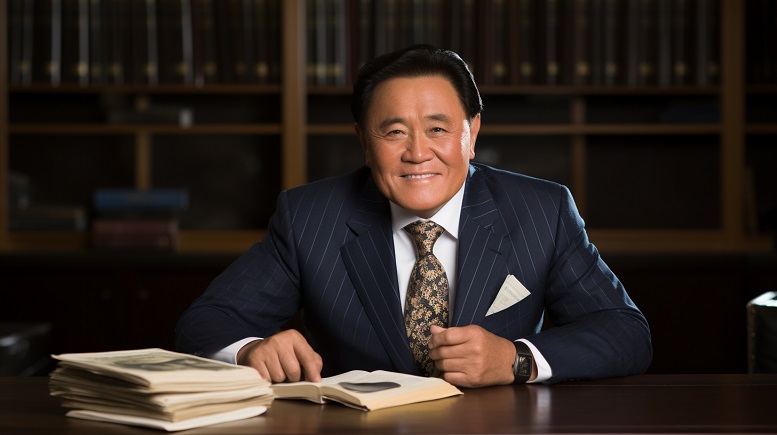Summary of the book “Rich Dad Poor Dad” – Robert Kiyosaki
“Rich Dad Poor Dad” is a captivating and thought-provoking book written by Robert T. Kiyosaki, which offers a unique perspective on financial education and wealth-building. In this article, we aim to provide a concise summary of the key takeaways from this influential book, focusing specifically on some of the most memorable sayings that have resonated with readers worldwide. As Kiyosaki shares his personal experiences growing up with two distinct father figures — his own biological father (poor dad) and his best friend’s father (rich dad) — he imparts invaluable wisdom that challenges conventional notions about money, success, and the path to financial independence.
Overview of the book “Rich Dad Poor Dad
“Rich Dad Poor Dad” is a bestselling personal finance book written by Robert Kiyosaki. The book revolves around the author’s childhood experiences and the lessons he learned from his two fathers – his own biological father (Poor Dad) and his best friend’s father (Rich Dad). Kiyosaki contrasts the different financial mindsets and strategies exhibited by these two influential figures in his life.
The author highlights that education is vital, but traditional schooling often fails to teach individuals about money and how to achieve financial success. He emphasizes the importance of acquiring financial literacy and understanding key concepts like assets, liabilities, cash flow, and investing. Kiyosaki encourages readers to adopt an entrepreneurial mindset, take risks, and build passive income streams to attain financial independence.
Throughout “Rich Dad Poor Dad,” Kiyosaki shares numerous insightful sayings that resonate with readers. Some of these include “The poor work for money, the rich make money work for them,” urging individuals to focus on building assets rather than relying solely on active income sources. Another notable saying is “It’s not how much money you make, it’s how much money you keep,” drawing attention to the significance of managing personal finances wisely by reducing expenses and increasing savings.
Key Takeaways:
1. Financial education is crucial: “Rich Dad Poor Dad” emphasizes the importance of financial education and how our lack of knowledge about money can limit our opportunities for wealth creation. The book encourages readers to learn about assets, liabilities, cash flow, and investment strategies as a means to achieve financial independence.
2. Mindset shift from employee to investor: One of the key lessons from the book is the need for a mindset shift from being an employee who solely relies on a salary to becoming an investor who generates passive income. It highlights that relying solely on a paycheck is limiting and encourages individuals to explore alternative sources of income such as building businesses or investing in real estate or stocks.
3. Leverage debt wisely: “Rich Dad Poor Dad” challenges conventional thinking by suggesting that not all debt is bad if used intelligently. The book explains how leveraging debt through investments can lead to greater returns and wealth accumulation. However, it also stresses the importance of understanding risk and making informed decisions before taking on any financial obligations.
Overall, “Rich Dad Poor Dad” provides valuable insights into financial literacy and encourages individuals to adopt a proactive approach towards achieving financial independence through education, mindset shifts, and strategic use of resources.
Key lessons from “Rich Dad Poor Dad
One of the key lessons from “Rich Dad Poor Dad” is the importance of financial education. The author, Robert Kiyosaki, emphasizes that traditional schooling often fails to teach students about money and how to make it work for them. He argues that understanding financial concepts such as assets, liabilities, and cash flow is crucial for achieving wealth and financial independence.
Another valuable lesson from the book is the difference between thinking like an employee and thinking like an entrepreneur or investor. Kiyosaki encourages readers to shift their mindset from solely relying on a salary or paycheck to seeking out opportunities to create passive income streams. He highlights the power of investments and building businesses as paths towards financial freedom.
Overall, “Rich Dad Poor Dad” stresses the importance of taking control of one’s financial future by acquiring knowledge, changing one’s mindset about money, and actively seeking opportunities for wealth creation. It serves as a guidebook for those who aspire to achieve financial success beyond simply working a nine-to-five job.
Financial Education:
Rich Dad Poor Dad,” written by Robert Kiyosaki, is a renowned financial education book that offers valuable insights on personal finance. The author shares his experiences growing up with two influential figures in his life: his highly educated but financially struggling father (poor dad) and his best friend’s wealthy father (rich dad). Through various anecdotes and lessons, Kiyosaki emphasizes the importance of financial literacy and challenges conventional beliefs about money.
One saying from the book that resonates with readers is “The rich don’t work for money; they make their money work for them.” This statement highlights the importance of investing and creating passive income streams rather than solely relying on traditional employment. Another notable quote is “The poor and middle-class work for money; the rich have money work for them.” It encourages individuals to shift their mindset from being an employee to becoming an investor or business owner, thus taking control of their financial destiny.
Kiyosaki’s “Rich Dad Poor Dad” serves as a wake-up call to many who have been conditioned to believe that a good education or a high-paying job guarantees wealth. Instead, he advocates for financial education as a means to achieve financial independence and ultimately attain true wealth.
The importance of financial literacy in the book
One of the key themes in “Rich Dad Poor Dad” is the importance of financial literacy. The book argues that traditional education does not adequately prepare individuals to understand and manage their finances. It emphasizes the need for people to educate themselves about money, investing, and building wealth.
The author shares several valuable sayings throughout the book that highlight the significance of financial literacy. For instance, he states that “the poor work for money, while the rich make money work for them.” This saying encourages readers to shift their mindset from being solely focused on earning a paycheck to understanding how to generate passive income and build assets.
Another important saying in the book is that “money flows from those who do not understand it to those who do.” This highlights the idea that individuals who lack financial knowledge are more likely to make poor decisions with their money, ultimately transferring it into the hands of those who have a better understanding of how wealth is created and managed.
Overall, these sayings underscore why financial literacy is crucial for achieving long-term financial success. They serve as reminders that it is not enough to simply earn a living; one must also be knowledgeable about how money works in order to effectively grow and protect their wealth.
The Rich vs. The Poor Mindset:
In the book “Rich Dad Poor Dad,” author Robert Kiyosaki explores the mindset differences between the rich and the poor. One of the key teachings in this book is that rich people focus on acquiring assets, while poor people tend to accumulate liabilities. The rich understand that assets generate income and increase their wealth over time, whereas those with a poor mindset often struggle to break free from a cycle of accumulating debts.
Another important concept highlighted in “Rich Dad Poor Dad” is the difference in attitudes towards financial education. The rich prioritize expanding their knowledge about money management, investing, and building businesses. They believe that education is essential for creating wealth and are always seeking opportunities to learn more. Conversely, many individuals with a poor mindset neglect financial education or rely solely on formal schooling to guide their financial decisions.
Kiyosaki emphasizes that these mindsets are not determined by one’s income level but rather by one’s beliefs and habits around money. By adopting a rich mindset – focusing on acquiring assets and continually educating oneself about finances – anyone can work towards achieving greater wealth and financial success.
Contrasting perspectives on wealth and success
In “Rich Dad Poor Dad,” author Robert Kiyosaki presents contrasting perspectives on wealth and success through the experiences of his two father figures. While his biological father, referred to as the “poor dad,” believed in working hard for a steady paycheck and job security, his friend’s father, the “rich dad,” emphasized the importance of financial education and building assets. This stark contrast highlights how traditional notions of success often prioritize a stable job and a high income, while overlooking the potential benefits of financial literacy and investment.
One saying that stands out in the book is “The poor work for money, while the rich make money work for them.” This encapsulates one of the key differences between how wealth is perceived by both fathers. The poor dad focused on relying solely on employment income to accumulate wealth, whereas the rich dad stressed utilizing passive income streams such as investments or businesses to generate wealth over time. This saying underscores how financial independence can be achieved by shifting from being an employee dependent on active income to becoming an investor who lets their money work for them.
Another significant quote from “Rich Dad Poor Dad” is “Don’t let fear control you.” Kiyosaki emphasizes that it is essential not to let fear dictate one’s financial decisions, as fear often leads to missed opportunities or conservative approaches that hinder growth. The rich dad’s mindset was rooted in taking calculated risks and learning from failures rather than succumbing to fear or playing it safe.
Building Assets, Not Liabilities:
In the book “Rich Dad Poor Dad,” author Robert Kiyosaki emphasizes the importance of building assets rather than liabilities. He argues that many people fall into the trap of accumulating liabilities, such as expensive cars, big houses, and credit card debt, which ultimately hinder their financial growth. Instead, he encourages individuals to focus on acquiring assets that generate passive income and appreciate in value over time.
Kiyosaki believes that assets are anything that puts money into our pockets, while liabilities are things that take money out of our pockets. He advises readers to invest in income-generating assets such as real estate properties or stocks instead of spending their earnings on consumable goods or material possessions with no potential for long-term financial gain.
By shifting one’s mindset from a consumer mentality to an investor mentality, Kiyosaki argues that individuals can build a strong foundation for financial independence and wealth creation. He emphasizes the need for financial education and understanding how money works to make informed decisions about investments and expenses. Overall, Kiyosaki’s message is clear: prioritize building assets over accumulating liabilities to secure a prosperous future.
How to create a strong financial foundation
One of the key principles emphasized in “Rich Dad Poor Dad” is the importance of creating a strong financial foundation. This involves understanding and managing your cash flow effectively. The book highlights the significance of budgeting and tracking your expenses to ensure you are living within your means and not accumulating unnecessary debt.
Another crucial aspect discussed in “Rich Dad Poor Dad” is the need to invest wisely. The book stresses that building wealth requires making your money work for you, rather than solely relying on income from a job. It encourages readers to educate themselves about different investment options such as stocks, real estate, and entrepreneurship. By diversifying their investments and seeking out opportunities with potential for long-term growth, individuals can strengthen their financial foundation.
Ultimately, creating a solid financial foundation is about developing good habits and adopting a mindset focused on building wealth over time. It requires discipline, patience, and an understanding of basic financial concepts. By implementing the teachings from “Rich Dad Poor Dad,” individuals can lay the groundwork for a secure financial future.
The Power of Investing:
The Power of Investing” is a subtopic that highlights the immense potential and impact of investing in one’s financial journey. One key takeaway from “Rich Dad Poor Dad” is the statement, “The rich don’t work for money; they make money work for them.” This powerful saying emphasizes the importance of harnessing the power of investments to create wealth and passive income streams.
The book also stresses that investing is not solely about stocks or real estate; it encompasses knowledge and education as well. The author shares his experience with his rich dad, who believed in constantly expanding one’s financial intelligence. Investing in oneself through learning and acquiring new skills opens doors to countless opportunities for growth and success.
Furthermore, “Rich Dad Poor Dad” emphasizes the significance of taking risks when it comes to investing. By stepping outside one’s comfort zone, individuals can discover lucrative investment avenues that may yield substantial returns. The book encourages readers to adopt a mindset focused on seeking out opportunities rather than shying away from risks, highlighting how this approach can empower individuals to achieve financial freedom and build lasting wealth through strategic investments.
Exploring the benefits of investing in assets
One key benefit of investing in assets is the potential for long-term wealth accumulation. As opposed to simply saving money, investing in assets allows individuals to grow their wealth over time. By carefully selecting and managing investments, individuals can potentially earn passive income through dividends, rental income, or capital appreciation. This not only provides financial security but also opens up opportunities for greater financial freedom and independence.
Additionally, investing in assets can act as a hedge against inflation. Unlike cash or savings accounts that may lose value due to inflationary pressures, certain assets have the potential to increase in value as prices rise. Real estate and stocks are two examples of assets that historically have shown resilience against inflation. By allocating a portion of one’s portfolio towards these types of investments, individuals can protect their purchasing power and maintain the value of their wealth over time.
Furthermore, investing in assets offers the opportunity to diversify one’s portfolio and spread risk across different asset classes. This can help mitigate the impact of market volatility on overall investment performance. By having a diversified portfolio that includes various types of assets such as stocks, bonds, real estate, or even commodities like gold or silver, investors are better positioned to weather economic downturns and reduce the likelihood of significant losses.
Overall, investing in assets provides numerous benefits including long-term wealth accumulation potential, protection against inflationary pressures on one’s purchasing power, and diversification opportunities for reduced risk exposure.
Conclusion:
In conclusion, “Rich Dad Poor Dad” offers valuable insights and wisdom on financial literacy. The book emphasizes the importance of financial education and understanding assets versus liabilities. It underscores the need to adopt a mindset of wealth creation rather than relying solely on traditional employment.
One key takeaway from “Rich Dad Poor Dad” is the concept of making money work for you instead of working for money. The author highlights the significance of investing in income-generating assets such as real estate or stocks, which can generate passive income over time. This approach allows individuals to build wealth and attain financial freedom.
Furthermore, the book stresses the significance of continuous learning and personal growth in achieving financial success. It encourages readers to expand their knowledge about money management, investing, and entrepreneurship. Overall, “Rich Dad Poor Dad” serves as an eye-opening guide that challenges conventional beliefs about money while offering practical advice on how to achieve financial independence.
Summary and final thoughts on “Rich Dad Poor Dad
In summary, “Rich Dad Poor Dad” is a personal finance book written by Robert Kiyosaki that highlights the author’s upbringing and his two influential father figures – his biological father (poor dad) and his friend’s father (rich dad). Kiyosaki shares important lessons he learned from both dads, emphasizing the importance of financial literacy and developing the mindset of an entrepreneur to achieve financial success.
Throughout the book, there are several notable sayings that resonate with readers. One such saying is “The rich don’t work for money, they make money work for them.” This emphasizes the significance of building passive income streams and investing in assets that generate cash flow rather than solely relying on earning a salary.
Another memorable saying is “It’s not how much money you make, but how much money you keep.” This reminds readers to focus on managing their expenses wisely and ensuring that they have control over their finances. By prioritizing savings and investments, individuals can build wealth over time.
In conclusion, “Rich Dad Poor Dad” offers valuable insights into personal finance through Kiyosaki’s own experiences. The book encourages readers to think differently about money, advocating for financial education as a means to achieve financial freedom. By implementing the principles discussed in the book, individuals can take steps towards improving their financial well-being and ultimately attaining economic independence.












